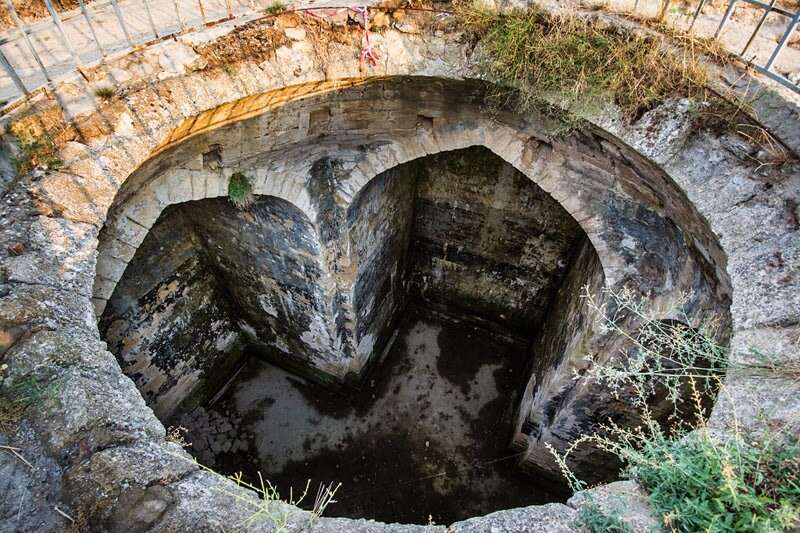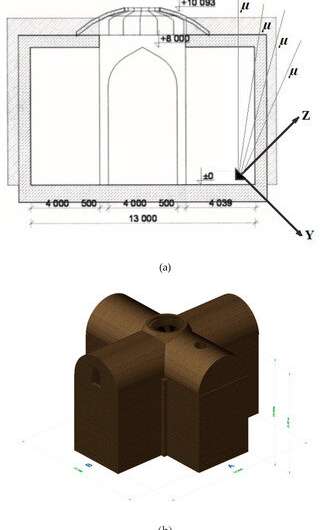The first 3-D images of the oldest Christian church in Russia obtained via muon radiography

NUST MISIS scientists and institutional collaborators have published the first results of a scan obtained by muon radiography of the underground space in the Derbent fortress of Naryn-Kala. The hypothesis of archaeologists regarding the use of the building as a Christian temple is most likely to be true. If this theory is confirmed, this building is one of the oldest churches in the world.
The 12-meter building is almost completely hidden under the ground. Only a fragment of a half-destroyed dome is visible above the surface. This building in the northwestern part of the Naryn-Kala fortress in Derbent dates back to about 300 A.D. To date, the function of the building has not been determined—a reservoir, a Christian temple, or a Zoroastrian fire temple. If this is really a Christian temple, it is the oldest Christian church in the country and one of the oldest in the world. It was buried in soil by Arabs after the capture of Derbent in about 700 A.D.
It is not possible for archaeologists to come to a consensus because excavations of the temple, used for two centuries as a reservoir, would destroy a UNESCO cultural heritage site. Therefore, to study the premises, scientists used muon radiography, placing several innovative detectors with a nuclear emulsion inside a buried building at a depth of 10 meters from the surface. The research lasted from May to September 2018. The first data obtained confirmed the effectiveness of the method for the study of this specific object.
The purpose of the experiment was to find out the possibility of studying the selected archaeological object using muon radiography, determine the optimal exposure, the number, size and location of the detectors, and get the first images of the site• using nuclear emulsions. The results obtained from the muon detector made it possible to confirm the reliability of the study of the building using muon radiography (which was not obvious given the similar density of soil around the building and the shell-limestone walls) and suggest a plan for a full-scale experiment to identify the contours of the building as a whole.

In the first test experiment, physicists saw an unusual distribution of muon fluxes in the western wing of the building, which may be related to the architectural features, distinguishable by fragments of walls located above ground. The construction, built of local shell-limestone, is about 11 meters high and extends 15 meters from south to north and 13.4 meters from west to east. Segments (arm) of a cruciform design have a width of about five meters, three arms of a length of about 4.2 meters, and the fourth (northern) measures more than 6 meters. The brackets are covered with vaults, and a dome wire frame with a diameter of five meters is located above the central part.
In a number of historical and reference sources, this construction is referred to as an underground water tank, as it was in the 17th—18th centuries. However, the first experiment gave reason to doubt this hypothesis. The building's features, including its cross shape and its orientation, were unusual for reservoirs, but common for early churches and fire temples.
"It seems very strange to me to interpret this building as a water tank. In the same fortress of Naryn-Kala, there is an equal underground structure of 10 meters depth, and it really is a tank. This is just a rectangular building. The unusual building has the shape of a cross, oriented strictly to the sides of the world. One side is two meters longer than the others. As the archaeologists who began excavations say, during construction, the building was entirely on the surface and it stands on the highest point of the Naryn-Kala. What is the sense of putting the tank on the surface, and even on the highest mountain? It is strange. Currently, there are more questions than answers," says NUST MISIS expert Natalia Polukhina.
As the authors of the study emphasize, the characteristics of the probing radiation require the subsequent irradiation of muon detectors in the area under study, and therefore, the continuation of the experiments. The installation of detectors on the western slope of the fortress outside the walls of the building will be especially effective to obtain a full-size underground image. The main result of the next stage of the experiments will be the final three-dimensional tomogram of the underground building, which will help to define the purpose of this unusual facility.
More information: Askerkhan Abiev et al, Muon Radiography Method for Non-Invasive Probing an Archaeological Site in the Naryn-Kala Citadel, Applied Sciences (2019). DOI: 10.3390/app9102040
Provided by National University of Science and Technology MISIS





















